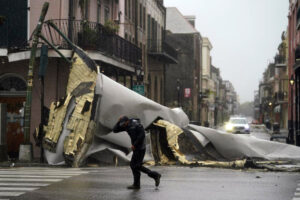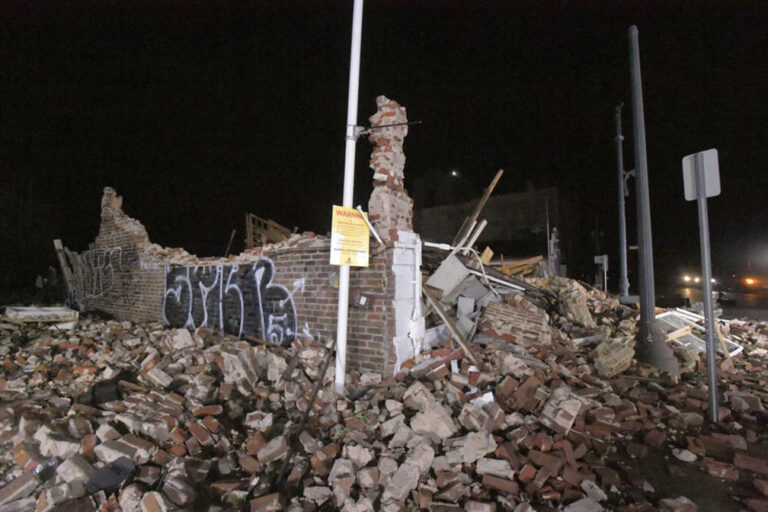NEW ORLEANS — Rescue workers set out in hundreds of boats and helicopters to reach people trapped by floodwaters and utility crews mobilized Monday, Aug. 30, after a furious Hurricane Ida swamped the Louisiana coast and shattered a large swath of the state’s electrical grid in the sweltering, late-summer heat.
One of the most powerful hurricanes ever to hit the U.S. mainland weakened into a tropical storm overnight as it pushed inland over Mississippi with torrential rain and shrieking winds, its danger far from over.
Ida was blamed for at least one death — someone hit by a falling tree outside Baton Rouge — but with many roads impassable and cellphone service knocked out in places, the full extent of its fury was still coming into focus Monday morning.
The Federal Motor Carrier Safety Administration has issued a regional emergency declaration for Louisiana, Mississippi, Alabama, Arkansas, Tennessee and Texas. The declaration grants temporary relief for drivers and carriers that are providing direct emergency response with the transport supplies, goods, equipment, fuel and persons. Click here to review the declaration and requirements.
The hurricane “came in and did everything that was advertised, unfortunately,” Louisiana Gov. John Bel Edwards said.

All of New Orleans lost power right around sunset Sunday as the hurricane blew ashore on the 16th anniversary of Katrina, leading to an uneasy night of pouring rain and howling wind. The weather died down shortly before dawn, and people began carefully walking around neighborhoods with flashlights, dodging downed light poles, pieces of roofs and branches.
“I had a long miserable night,” said Chris Atkins, who was in his New Orleans home when he heard a “kaboom” and all the sheetrock in the living room fell into the house. A short time later, the whole side of the living room fell onto his neighbor’s driveway.
“Lucky the whole thing didn’t fall inward. It would have killed us,” he said.
Four Louisiana hospitals were damaged and 39 medical facilities were operating on generator power, the Federal Emergency Management Agency said.
An area just west of New Orleans got about 17 inches of rain in 20 hours, Greg Carbin of NOAA’s Weather Prediction Center tweeted.
It appeared that the levees that failed in 2005 during Hurricane Katrina held up in Ida, the governor said.
“For the most part, all of our levees performed extremely well — especially the federal levees — but at the end of the day the storm surge, the rain, the wind all had devastating impacts,” Edwards said. “We have water systems that are out. We have tremendous damage to homes and to businesses.”
The rain and surge of seawater in the maze of rivers and bayous south of New Orleans threatened hundreds of homes. On social media, people posted their addresses and directed search-and-rescue teams to their attics or rooftops.
The Louisiana National Guard said it activated 4,900 Guard personnel and lined up 195 high-water vehicles, 73 rescue boats and 34 helicopters. Local and state agencies were adding hundreds of more.
Jefferson Parish in suburban New Orleans knew of 500 people who said they were going to stay in areas that were flooded, and it began sending out dozens of boats to account for everyone and start rescuing them, Parish Council member Deano Bonano told WWL-TV.
More than a million customers in Louisiana and Mississippi were without power, according to PowerOutage.US, which tracks outages nationwide. That left them without air conditioning and refrigeration in the dog days of summer.
The hurricane twisted and collapsed a giant transmission tower in Jefferson Parish along the Mississippi River, and the wires fell into the river, causing widespread outages and halting river traffic, parish Emergency Management Director Joe Valiente said. Those lines supplied power to the New Orleans area.
“One-hundred percent of the grid is smashed, hundreds of telephone poles snapped, trees hit power lines and just ripped them out,” Valiente told NPR. He said that the entire power grids collapsed in about 10 parishes and that it could take six weeks to fully restore power.
Entergy said all eight of its major transmission lines into New Orleans were down and the only power was coming from generators, the city’s emergency office tweeted, citing “catastrophic transmission damage.” The city relies on Entergy for backup power for its stormwater pumps.
Edwards said on Sunday that 30,000 utility workers were in the state to help restore electricity.
New Orleans’ levees underwent major improvements after Katrina, which breached the city’s flood defenses, caused catastrophic flooding and was blamed for 1,500 deaths. Ida posed the levee system’s biggest test since that disaster.
Farther south, emergency officials had not heard from Grand Isle since Sunday afternoon. About 40 people stayed on the barrier island, which took the brunt of the hurricane and was swamped by seawater, Jefferson Parish President Cynthia Lee Sheng told NBC.
Ida’s 150 mph winds tied it for the fifth-strongest hurricane ever to hit the mainland. Its winds were down to 45 mph early Monday, and forecasters said it would rapidly weaken while still dumping heavy rain over a large area.
Parts of Interstate 10 — the main east-west highway along the Gulf Coast — were closed because of high water and debris on the road. At one spot, near LaPlace, Louisiana, the water over the highway was at least 4 feet deep, state officials said.
In Mississippi’s southwestern corner, entire neighborhoods were surrounded by floodwaters, and many roads were impassable.
Ida was expected to pick up speed Monday night before dumping rain on the Tennessee and Ohio River valleys Tuesday, the Appalachian mountain region Wednesday and the nation’s capital on Thursday.
Forecasters said flash flooding and mudslides are possible along Ida’s path before it blows out to sea over New England on Friday.
By Rebecca Santana, Kevin McGill and Janet McConnaughey. Associated Press writers Emily Wagster Pettus in Jackson, Mississippi; Seth Borenstein in Kensington, Maryland; Michael Biesecker in Washington; Sudhin Thanawala in Atlanta; and Jeffrey Collins in Columbia, South Carolina; contributed to this report.
The Associated Press is an independent global news organization dedicated to factual reporting. Founded in 1846, AP today remains the most trusted source of fast, accurate, unbiased news in all formats and the essential provider of the technology and services vital to the news business. The Trucker Media Group is subscriber of The Associated Press has been granted the license to use this content on TheTrucker.com and The Trucker newspaper in accordance with its Content License Agreement with The Associated Press.






